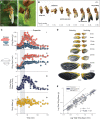Transient use of hemolymph for hydraulic wing expansion in cicadas
- PMID: 37072416
- PMCID: PMC10113369
- DOI: 10.1038/s41598-023-32533-4
Transient use of hemolymph for hydraulic wing expansion in cicadas
Abstract
Insect wings must be flexible, light, and strong to allow dynamic behaviors such as flying, mating, and feeding. When winged insects eclose into adults, their wings unfold, actuated hydraulically by hemolymph. Flowing hemolymph in the wing is necessary for functioning and healthy wings, both as the wing forms and as an adult. Because this process recruits the circulatory system, we asked, how much hemolymph is pumped into wings, and what happens to the hemolymph afterwards? Using Brood X cicadas (Magicicada septendecim), we collected 200 cicada nymphs, observing wing transformation over 2 h. Using dissection, weighing, and imaging of wings at set time intervals, we found that within 40 min after emergence, wing pads morphed into adult wings and total wing mass increased to ~ 16% of body mass. Thus, a significant amount of hemolymph is diverted from body to wings to effectuate expansion. After full expansion, in the ~ 80 min after, the mass of the wings decreased precipitously. In fact, the final adult wing is lighter than the initial folded wing pad, a surprising result. These results demonstrate that cicadas not only pump hemolymph into the wings, they then pump it out, producing a strong yet lightweight wing.
© 2023. The Author(s).
Conflict of interest statement
The authors declare no competing interests.
Figures



References
-
- Arnold JW. Blood circulation in insect wings. Memoirs Entomol. Soc. Can. 1964;96(S38):5–60. doi: 10.4039/entm9638fv. - DOI
-
- Pass G, Tögel M, Krenn H, Paululat A. The circulatory organs of insect wings: Prime examples for the origin of evolutionary novelties. Zoologischer Anzeiger. 2015;256:82–95. doi: 10.1016/j.jcz.2015.03.008. - DOI
-
- Ganguli R, Gorb S, Lehmann FO, Mukherjee S. An experimental and numerical study of Calliphora wing structure. Exp. Mech. 2010;50(8):1183–1197. doi: 10.1007/s11340-009-9316-8. - DOI
-
- Truman JW. Neuroethology and Behavioral Physiology: Roots and Growing Points. Springer; 1983. Insect ecdysis: A system for the study of internal chemicals that control behavior; pp. 167–175.
Publication types
MeSH terms
LinkOut - more resources
Full Text Sources

